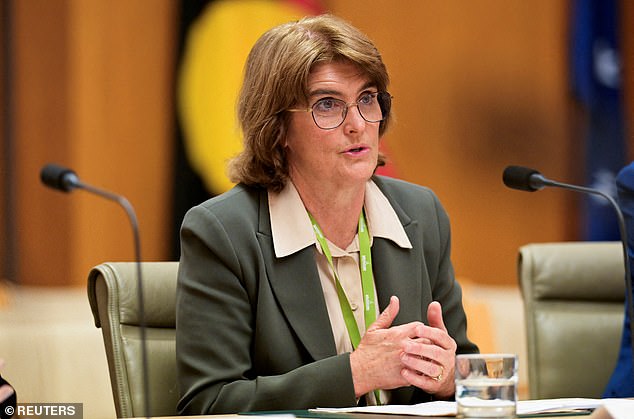Millions of home borrowers have been told to forget about more rate cuts because inflation is in danger of climbing again.
The Reserve Bank last month cut interest rates for the first time since November 2020 but the minutes of that meeting, released on Tuesday, suggested the board had little enthusiasm to keep cutting rates.
‘They emphasised that the decision at this meeting acknowledged the progress that had been made in reducing inflation while not committing the board to ease policy further,’ the minutes said.
The RBA minutes, of its most recent two-day meeting, also suggested the cash rate could stay at 4.1 per cent for an extended period, or even go up again.
‘If the evolving data signalled that inflation was proving more persistent than expected, it would be reasonable to maintain a more restrictive stance of policy by holding the cash rate at 4.1 per cent for an extended period – given members’ assessment that this level would still be restrictive – or by even tightening policy if the outlook was for inflation to rise materially,’ it said.
The Reserve Bank cut rates on February 18 and also released new forecasts having headline inflation climbing to 3.7 per cent by late 2025, up from 2.4 per cent in the December quarter, following the expiry of the federal government’s $300 electricity rebates.
‘Headline inflation was expected to exceed 3 per cent temporarily owing to the scheduled unwinding of cost-of-living measures,’ the February meeting minutes said.
The consumer price index, on a quarterly basis, is now at a three-year low and firmly within the Reserve Bank’s two to three per cent target.

The Reserve Bank last month cut interest rates for the first time since November 2020 but the minutes of that meeting, released on Tuesday, suggested the board had little enthusiasm to keep cutting rates (pictured is Governor Michele Bullock)
But KPMG chief economist Brendan Rynne said a rate cut would be unlikely at the RBA’s May meeting, which would be occurring after the late April release of March quarter inflation data.
While quarterly inflation is easing, other price measures show the cost-of-living fight is far from over.
Monthly inflation data for January showed headline inflation rising by 2.5 per cent, which was worse than the 2.3 per cent figure for November.
‘The hotter-than-expected inflation figures last week supports our forecast that the RBA will not follow up its recent rate cut with another in May,’ Dr Rynne said.
‘The data also support the RBA’s guidance to the market to be cautious about the scope for further rate cuts in the near term.’
The Reserve Bank minutes noted Australia’s previous cash rate of 4.35 per cent, following the 13 hikes in 2022 and 2023, was lower than most other advanced economies.
‘Members observed that not having lifted interest rates as high as in countries that had faced a similar inflation challenge meant the board should be cautious when deciding to lower the cash rate,’ it said.
The RBA’s existing 4.1 per cent cash rate, however, is still much higher than Canada’s equivalent policy rate of 3 per cent, following six cuts there since last year.

The RBA minutes also suggested the cash rate could stay at 4.1 per cent for an extended period, or even go up again (pictured are shoppers in Sydney’s Pitt Street Mall)
It is also higher than New Zealand’s 3.75 per cent cash rate, following four cuts across the Tasman.
Services inflation in Australia was still high at 4.3 per cent in the December quarter and new data released on Tuesday could make the RBA nervous.
Australian Bureau of Statistics retail figures for January showed a 1.1 per cent monthly increase in spending for cafes, restaurants and takeaway food.
Robert Ewing, the ABS’s head of business statistics, said spending on leisure activities was going up even before the Reserve Bank’s latest rate cut.
‘Bumper crowds across large-scale events, including record attendance at the Australian Tennis Open and cricket events, lifted spending in catering services,’ he said.
A halving of iron ore prices since 2021, as a result of weaker demand from China for the commodity used to make steel, has also meant Australia now owes the rest of the world more money.
The current account deficit of $52.4billion for 2024 was the biggest since 2016.
The Reserve Bank is expecting the Australian dollar, now worth just 62 US cents, to remain weak, which risks keeping inflation high if imports are more expensive.
‘The depreciation reflected broad-based US dollar strength associated with the prospect of tariffs … and ongoing uncertainty around the outlook for the Chinese economy,’ the RBA minutes said.
The Reserve Bank’s latest signal contradicts financial markets, which are expecting more rate cuts.
Westpac and the Commonwealth Bank are expecting three more rate cuts that would take the RBA cash rate back to 3.35 per cent for the first time since March 2023.
The RBA’s next monetary policy decision is due to be announced on April 1, also known as April Fools’ Day.







